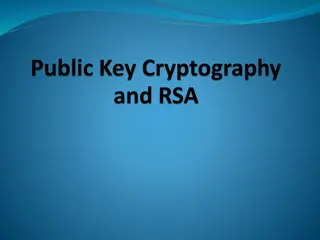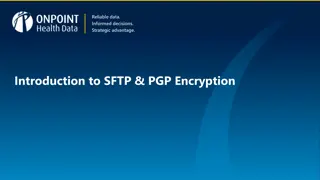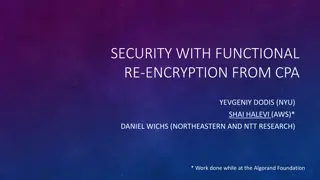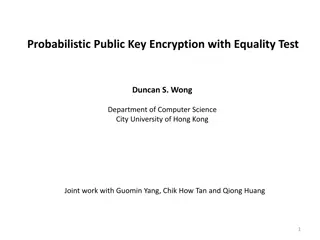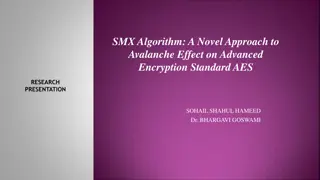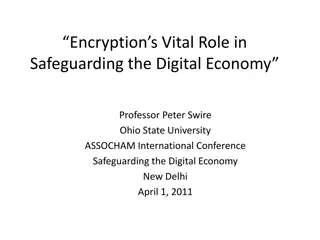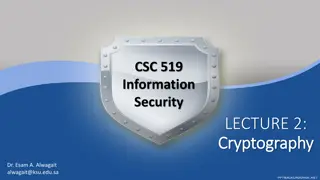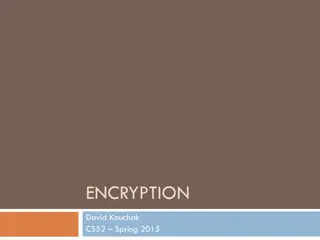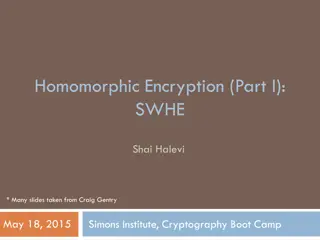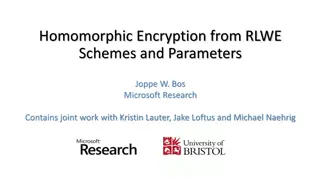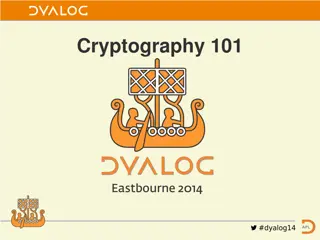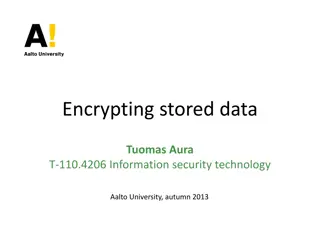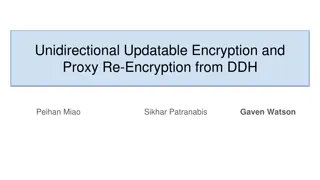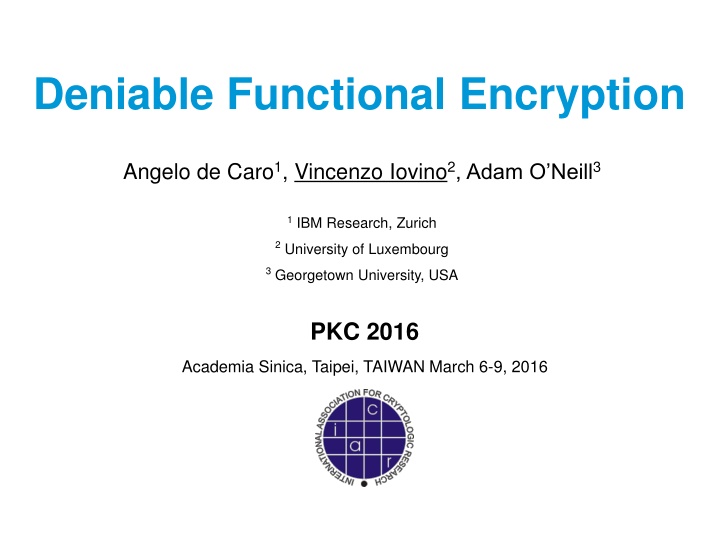
Functional Encryption and Deniability: Enhancing Security
Explore the concept of deniable functional encryption, secure routing, and receiver-deniable FE through intriguing scenarios and efficient constructions. Learn how this encryption paradigm enhances security and privacy in communications.
Download Presentation

Please find below an Image/Link to download the presentation.
The content on the website is provided AS IS for your information and personal use only. It may not be sold, licensed, or shared on other websites without obtaining consent from the author. If you encounter any issues during the download, it is possible that the publisher has removed the file from their server.
You are allowed to download the files provided on this website for personal or commercial use, subject to the condition that they are used lawfully. All files are the property of their respective owners.
The content on the website is provided AS IS for your information and personal use only. It may not be sold, licensed, or shared on other websites without obtaining consent from the author.
E N D
Presentation Transcript
Deniable Functional Encryption Angelo de Caro1, Vincenzo Iovino2, Adam O Neill3 1 IBM Research, Zurich 2 University of Luxembourg 3 Georgetown University, USA PKC 2016 Academia Sinica, Taipei, TAIWAN March 6-9, 2016
Deniable Encryption (explained to kids) Grrr Is there a man in the middle?!? I intercepted this Ohhh I am so sorry, will you ever forgive me? encrypted msg, show me what is inside! How can you doubt my fidelity?! This is my SK, see with your own eyes We will see tonight See you tonight. Adam See you tonight. Adam Laundress Your husband s suit is ready. The = Setup(1 )
Functional Encryption PK MSK Token(f)=KeyGen(MSK,f) f Enc(msg) Example: Email Filter msg msg= From XXX To XXX Body XXX f(msg) { If From= Adam return Priority, If From= Bob return Discard, Else . f(msg)=
Motivating Deniability for FE: Secure Routing Encrypted package goes from Alice to Adam Each router has a token for its routing table With tokens routers can compute next hop Router, I suspect that my wife is cheating on me. Can you tell me what is the next destination of this msg of hers that I intercepted? Routers can not leak other information, e.g. final or previous hops in the path Router has 6 possible next hops for the package Adam s message followed the pink one but the router gives to Bob a FSK that shows as next hop the green one 5
Our Results Receiver-deniable FE for general functions BB from any FE Receiver-deniable FE in the multi-distributional model Relations between Sim-Security and Deniability Efficient constructions
Receiver-deniable FE Receiver Deniability Games: RealRecDenExp and FakeRecDenExp RealRecDenExp K1(f, Ct*, x*): Sk f= KeyGen(Msk, f); Output: Skf FakeRecDenExp K2(f, Ct*, x*): Sk f= RecFake(Msk, Ct,* x*); Output: Skf Challenger AdvO1,O2,K PK Ct = Enc(PK, x; r); Skf = RecFake(Msk,Ct,y); f(y) = Dec(Ct,Skf); Ct = Enc(PK,x ; r); f(x ) = Dec(Ct , Skf); Msk O1(f,x,y): Ct = Enc(PK,x;r); Skf= KeyGen(Msk, f); Output: (Ct,Skf) O2(f,x,y): Ct = Enc(PK, y; r); Skf = RecFake(Msk, f, Ct, x); Output: (Ct, Skf) (x*,y*) Real: Ct* = Enc(x*;r) Fake: Ct*=Enc(y*;r) Constraints 1. No query (f, x, y) issued to O1/O2 and at same time a query (f, Ct*, x) to K1 /K2; view 2. For any query to oracle K1/K2 for f*, there is no query f* to O1/O2; Note: Adv has access to K( ,Ct*,x*) only after seeing Ct 3. For each f different from any of the f* queried to O1/O2, it holds that f(x*)=f(y*). ~ ~ Adversary s view in RealExp with K=K1 Adversary s view in FakeExp with K=K2
Multidistributional Receiver-deniable FE MultiDist RecDen Games: ReadMDRecExp and FakeMDRecExp RealMDRecExp K1(f, Ct*, x*) Skf= KeyGen(Msk, f); Output: Skf FakeMDRecExp K2(f, Ct*, x*) (Skf, Fkf) = DenKeyGen(Msk, f); Skf= RecFake(Msk, Ct*, x*); Output: Skf Challenger AdversaryO1,O2,K (x*,y*) Ct = Enc(PK, x; r); (Skf, Fkf) = DenKeyGen(Msk, f); Skf = RecFake(Skf, Fkf ,Ct, y); f(y) = Dec(Ct, Skf ) Real: Ct* = Enc(x*;r) Fake: Ct*=Enc(y*;r) O1(f,x,y) Ct = Enc(PK,x;r); Skf= KeyGen(Msk, f); Output: (Ct,Skf) O2(f,x,y) Ct = Enc(PK, y; r); (Skf, Fkf) = DenKeyGen(Msk, f); Skf= RecFake(Skf, Fkf, Ct, x); Output: (Ct, Skf) PK Constraints 1. No query (f, x, y) issued to O1/O2 and at same time a query (f, Ct*, x) to K1 /K2; view 2. For any query to oracle K1/K2 for f*, there is no query f* to O1/O2; Note: Adv has access to K( ,Ct*,x*) only after seeing Ct 3. For each f different from any of the f* queried to O1/O2, it holds that f(x*)=f(y*). Adversary s view in FakeMDRecExp with K=K2 ~ ~ Adversary s view in RealMDRecExp with K=K1
Starting point: DIJOPP13s transform Functionality in Normal Mode: Functionality in Trapdoor Mode: Simulated Token Simulated ciphertext Token(C) Enc(m) Decryption Decryption f(m) f(m)
DIJOPP13s transform (simplified) IND-secure scheme: Ciphertext msg Token f SIM-secure scheme: Ciphertext Token [msg , flag , encryption key] [msg,0,$] [0n,1,key] [f, encrypted output] [f,$] [f , Enckey(f(msg))] Normal mode Trapdoor mode
Trapdoor circuit for RecDen (simplified) Circuit Trap[C,t,z,t ,z ](x ): (x,s) x ; If F(s,t)=z return 1; Else if F(s,t )=z return 0; Else return C(x); Target Ciphertext Ct*=Enc(x,s) Other Ciphertexts Decryption Decryption 1 if Fs(t)=z 0 if Fs(t )=z C(x)
MultiDistRecDen (General Idea) Token=(Trap2Tok, TCt), where Trap2Tok is a Token for a trapdoor circuit for a 2-FE Link Trap2Tok and TCt: TCt encrypts z and trapdoor circuit embeds value t s.t. f(z)=t Using Fake key = z compute fake TCt=Enc(z,Ct*,y) for target ciphertext Ct*=Enc(x) and feed Trap2Tok with (Ct*, TCt) Decrypt(Trap2Tok, Ct*,TCt)=C(y)
MultiDistRecDen Construction (simplified) c=Ct Trapdoor mode c Ct Normal mode Tok(C)=(Trap2Tok[t], TCt=Enc(z, Ct, x )) Tok(C)=(Trap2Tok[t], TCt=Enc(z, c, x )) Ct =Enc(x) Circuit Trap2Tok[t](Ct, TCt): 1. [Check that TCt is the one linked in Fake2Tok] if (f(z) t) return error 2. [Trapdoor mode] If (c=Ct) return C(x ) 3. [Normal mode] Else return C(x) C(x ) C(x)
Negative implications and Optimality of our results (nc,nk)-receiver deniability = deny nc ciphertexts and nk tokens (nc,nk)-receiver deniability (0,nc,nk)-Sim-security Impossible Receiver deniability stronger: equivocable ciphertexts and tokens must decrypt correctly in the real system SIM-secure FE impossibility (nc, poly)-deniability is in fact optimal we achieve optimal parameters
Efficient construction for Boolean Formulae RecDen IBE lattice-based assumptions [OPW11] Implement Boolean Formulae with Inner-Product Encryption RecDen Boolean Formulae Encryption Inner-Product Encryption [This work] Implement equality with bitwise comparison To avoid exponential blowup we must bound the length of the variables s, r0 and r1 to be a constant t Decryption error non-negligible Use parallel repetition to fix the issue
& Vincenzo thanks FNR (Luxembourg) to fund his research and Gabriele Lenzini for the drawings in the 3rd slide


